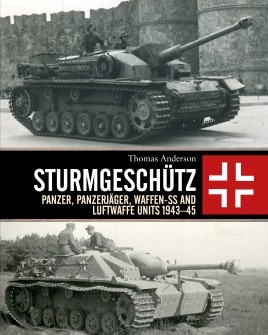Sturmgeschutz
Initially deployed with German forces in 1940, Sturmgeschütz (Stug) assault guns were purpose-built fully tracked armored fighting vehicles designed to support the infantry during the initial assault on enemy positions, especially useful for knocking out strong points such as bunkers. When the Germans invaded Russia in 1941 in Operation Barbarossa, they got a nasty surprise with the appearance on the battle field of heavily armed and armored Soviet tanks such as the T-34/76 and KV-1. The Stug assault guns were discovered to be excellent tank destroyers. They were quicker and cheaper to produce than tanks, making them a good “bargain” on the battlefield. As the war progressed, the Stug was up-gunned to deal with ever more lethal Soviet tanks, and spread across the battle fields as German industry struggled to keep up with tank losses.
For anyone interested in modeling World War 2 German armored vehicles, the name Thomas Anderson should be well known. He has spent years researching these vehicles and is himself a modeler, having published numerous articles in various modeling publications, as well as authoring a number of German AFV books.
This latest book by Anderson on the Sturmgeschutz is subtitled: Panzer, Panzerjager, Waffen-SS and Luftwaffe Unites 1943-45. It is 270 pages in length, the pages being 7.5” x 9.5” in size. The book contains over 200 photographs sourced from the German national archives as well as from private collections. The reproductive quality of the photographs ranges from acceptable to good.
The book is broken down thus:
- Introduction: pages 6 thru 23
- Chapter 1: Waffen-SS pages 24 – 51
- Chapter 2: Luftwaffe Field Divisions pages 52 – 85
- Chapter 3: 1943 – in the Panzertruppe pages 86 – 123
- Chapter 4: Special Formations pages 124 – 155
- Chapter 5: Infantry Formations pages 156 – 193
- Chapter 6: Increased Production pages 194 – 227
- Chapter 7: ‘neuses Sturmgeschutz’ in 1945 pages 228 – 255
- Chapter 8: Conclusion pages 256 – 265
Sturmgeschutz vehicles were originally assigned to artillery units (sturmartillerie), and early on in their deployment were in very short supply. As such, they weren’t assigned to any particular division, but were assigned to areas of greatest need in the field by the Generals overseeing any given battle. As their great utility as both infantry support vehicles and especially as tank destroyers was realized, production of Stugs increased. Divisional commanders started requesting dedicated Stug units of their own, rather than having to request units be sequestered to their area, and hoping there were some available when a need arose.
As production of Stugs increased, Divisional units did indeed start receiving their own Stug batteries. And given the highly politicized nature of the German military, the units that got the Stugs first were the ones with the greatest “pull” within the Nazi regime. This meant Heinrich Himmler’s SS. The first SS division to receive its own dedicated Stug unit was Leibstandarte-SS Adolf Hitler in the second half of 1940. Other SS Divisions followed. Not content to have only aircraft squadrons under his command, Herman Goring, head of the Luftwaffe, started angling to get field divisions early on in the war. And once these were approved for creation, their commanders demanded the very best equipment, which of course included Stugs! Last in line was the Army itself, which once Stugs were rolling off the production lines in large enough quantities, started to get their own dedicated Stug units. All this is detailed by author Anderson as one proceeds through this book.
On the plus side, there is lots of very informative information in this book about Stugs and Stug units. This information is buttressed by over 200 nicely laid out period photographs of the vehicles under discussion. There are also copies from historical archives of original organizational structures of Stug units, etc. However, there are a number of negatives in this book. Firstly, whoever oversaw the production of this book apparently failed to utilize a proof reader. There is a lot of poor grammar in this book and there are a lot of words missing from sentences. This is not a deal breaker, but I found it extremely annoying. I had difficulty getting flow to my reading, often having to pause to figure out what word was missing, or what, exactly, the author meant to say, rather than what he actually said. As for the various historical documents detailed within the pages of the book, many of them to me were rather worthless, as there was no key next to them, explaining what, exactly, all the little symbols represent on a particular organizational structure diagram.
In conclusion? Well, if you are really into Stugs, then this book probably is for you. The photographs alone, 200 or so, are a mine of useful information. The author also clearly knows a lot about the subject matter, and so it is a shame that a proof reader wasn’t utilized to improve both the layout of the work, dramatically improve the grammar, and insure that words weren’t randomly missed throughout the text. If you aren’t a big Stug fan, and you are looking for a simple primer on the subject of Stugs, perhaps looking elsewhere would be a better bet. I AM a Stug fan, and despite the flaws with the written words, found it full of insightful information and photographs. I would like to thank Osprey Publishing for providing IPMS USA with this review copy.





Comments
Add new comment
This site is protected by reCAPTCHA and the Google Privacy Policy and Terms of Service apply.
Similar Reviews